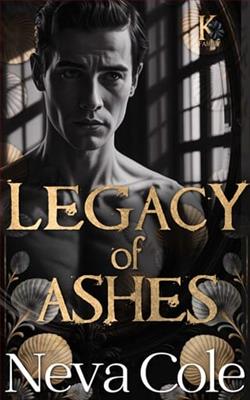Page 81 of The Pairing
“Won’t they revoke your French passport?”
“Let’s find out.”
I jump up onto one of the stone stanchions keeping visitors off the lawn and do all the most cliché, embarrassing tower-tourist poses—holding it up, kicking it over, back-to-back lean—until Theo stops taking pictures and starts begging me to stop, screaming with mortified laughter. It works, though. When I tell her she has to do one now, she laughs and sighs and says, “Fine.”
I line up the shot: Theo with grease-smudged hands in front of an 850-year-old tower, both of them tall and gorgeous and beaming.
“Oh, wow,” she says when I show her the photo. “I actually really like this one.”
“Yeah?”
She touches the back of my hand as she passes the phone back. “Yeah.”
Theo’s been like this about photos since we were eleven, when she still went to premieres for her sisters’ projects. It was the big one, the Willem Dafoe movie that both Sloane and Este were in, and Theo wore a blue suit with a flower-print tie. Flowers for Flowerday, she said.
It never occurred to me that it would matter to anyone. It didn’t occur to Theo either, and certainly not to her parents, who never cared when Theo asked for haircuts and clothes meant for boys. That was just how Theo had always been. Butfor some reason it mattered to red-carpet reporters, who wrote breathless articles about how heartwarming and progressive it was for two famous people to let their daughter wear a suit to an event, and what an inspiring gender hero Theo was. They made it into a whole thing.Diversity win! Child wears clothes.
Tabloids didn’t exist in Theo’s household, but if one comes from a famous family, one might look oneself up on one’s best friend’s family computer eventually. We were thirteen. She stopped posing for pictures after that, and she didn’t get a haircut for years.
I’ve always thought Theo could pull off anything she wanted. I liked her just as much in slip dresses and lip gloss as I did in T-shirts and cotton boxers, and I didn’t care if she chose to leave one for the other. But sometimes, when she leaned in to the mirror to put on lipstick or tugged the front of her shirt away from her chest, I would see her eyes go somewhere else, like she wasn’t quite inside the body she was dressing up.
In her photo with the tower, I see someone filling up their body all the way to the skin. It’s in the loose set of her shoulders under her shirt, her broad stance, the jut of her chin, her short hair flying across her forehead in wild, boyish waves.
“I love your hair this length,” I tell her as we walk toward thecathedral. “It’s so good on you.”
“I like it too,” she says, readying her ticket for the guard. Her expression is soft, inquiring. “I feel like I finally look like myself, you know?”
We walk into the cathedral, between huge Corinthian columns topped with acanthus leaves and through Romanesque arches with alternating black and white stripes of marble. Above the central nave is a gilded ceiling, each ornate coffer decorated with flowers and faces of angels. We split at the cross point of the nave and the transept, where the dome is painted with the Virgin Mary gliding toward heaven in a whirlpool of golden clouds.
When I moved to Paris, Dad told me to guard my wonder. He said that the danger of living in a place of dreams is that it can become ordinary. His exact words were,Novelty is half of sublimity,the kind of thing that once made me believe he was a genius and now makes me picture Theo doing a jerk-off hand gesture. Still, somewhere during the long hours at work making the same gelée for three months straight, I lost my appetite for taking in the view on my way home. I stopped noticing all the beauty that once astonished me when I read about it in books.
I was full of wonder when I was studying art. The quality that made me choose Renaissance artists as my concentration so I could write obsessive pages about their attention to human emotion and bodies, the part of me so infatuated with the Baroque that Theo made me put a dollar in a jar every time I brought up Bernini—it left me not long after Theo, but much more quietly. I barely noticed until Bordeaux, when I stepped off the bus at the château and felt wonder return like an old friend. Every stop since, I’ve slowly unfolded, opening to it again.
Here at the apse of the cathedral, I remember how it felt to be eighteen and falling in love with a history of art coursecatalog. I look at the massive oil paintings and recite pigments of the Renaissance palette, azurite and vermilion, verdigris and gamboge. I remember when I learned their names, how I imagined being some sixteenth-century cheese maker seeing paint give off light for the first time. I don’t know if it’s Italy or Theo bringing it all back, but I’m so thankful to both.
I find Theo by a golden casket, reading something on her phone.
“I’m looking this guy up,” Theo says, jerking her chin toward the coffin. “It’s Saint Ranieri, patron saint of Pisa. I feel like we could be friends. It says, ‘He was a traveling musician who played all night and slept all day.’”
I smile, enjoying the way her mind works, and lean in to read the screen. “‘His life revolved around food, drink, and partying.’ I’ve slept with this Italian boy before.”
She scrolls down. “Oh, but then he joins a monastery and gives away all his possessions. But look, one of his miracles is multiplying bread. You’d love that.”
“Depends on the bread. Let’s do the camposanto next.”
We walk on to the long cemetery spanning the piazza’s entire north side. I follow Theo through the arches and thousands of meters of frescos, still thinking of my imaginary cheese maker and those impossible, luminous oil-mixed paints he would have never seen before. They probably looked to him the way Theo looks to me now.
Beside the camposanto is the round baptistery, its domed roof half terracotta tiles and half brown and gray sheets of lead. I read once that the exterior was finished nearly two centuries after it was begun, and it shows in the way the structure literally evolves upward in complexity, starting with simple Byzantine columns and ending in ornate, pointed Gothic arches up top. Inside, it’s almost all empty white-gray marble except for the font at the center of the floor and the sculpted pulpit over it. The rest is open, encircled by two tiers of massive arches holding upa high, curved ceiling.
“Kit, look at this,” Theo says, pointing to a sign about the mathematics of the baptistery’s roof. “What do you think it means by ‘acoustically perfect’?”
Before I can guess, a badged guard steps away from her station and declares, “Silenzio.”
Theo’s eyes widen as the murmur of visitors drops off into silence. From beneath one of the tall arches, we watch the guard walk to the font, directly under the highest point of the ceiling. And then she begins to sing.
At first, she holds one long, clear tone, an openahthat unfurls to the yawning ceiling and expands to fill it. Then she sings a second, lower note, but the first note still hangs in the air, resonating among the marble walls as if she’s still holding it. She sings a third, higher note. The echoes layer over one another, so loud and rich it’s as if a choir of ghosts is in the loggia harmonizing with her. But it’s only her own voice lasting on and on, over and over, harmonizing with itself.
An expression of delighted awe dawns on Theo’s face, and in it I see layer after layer, old self after intermediate self after current self, the Theo I met as a child and the Theo I got to call mine and the Theo who fills her own body. They’re all here, hanging in the air, harmonizing with one another. Maybe they’re always here. Maybe she feels so familiar and so new to me now because I’d heard the beginning note but not the completed chord. I knew her before her arches had points, before the paint to finish her had been invented.















